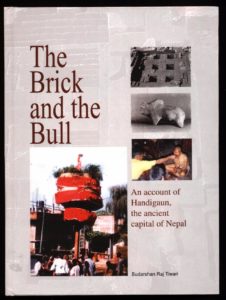 |
The Brick and the Bull: AnAccount of Handigaun, the Ancient Capital of Nepal Sudarshan Raj Tiwari. Himal Books, 2002, x, 225 p., ills., Rs 1150. ISBN 99933-43-52-8.
Contents: Preface. 1. A Brahmin from Handigaun. 2. The ‘birthday’ of Handigaun. 3. Handigaun: a gem among places. 4. The Kirat arrive in Kathmandu. 5. The Gods arrive in Handigaun. 6. The travels of the brick and the bull. 7. Religions of the Khas and the Kirat. 8. Andipringga: the Kirat Handigaun. 9. The art and antiquities of Andipringga. 10. Gods in crisis or happenings of history? 11. The Vishalnagar of legends: the first settlement or an expanded Andipringga? 12. The Lichchhavi take over. 13. The Madhyama Rajkul palace. 14. King Jayaverma of Maligaun. 15. Lichchhavi waterworks about the capital region. 16. Dharmadev is sacrificed and the Goddess of Andipringga becomes Torandevi. 17. Mandev, Mangriha and Maneswor. 18. Kailashkut Bhavan of Amshuverma. 19. Mangriha loses power. 20. The royal crisis of legitimacy and the jatra of Satyanarayan. 21. The Khat Jatra of Satyanarayan. 22. Religious conflict causes a fire at Vishalnagar. 23. Lichchhavi antiques in Handigaun. 24. The planning of Maneswor: a Desya Mandala. Glossary. References. “Handigaun is the earliest known urban settlement of Kathmandu Valley. As the site of the great palaces of the Kirat and Lichchhavi kings such as Mangriha and Kailashkut Bhavan, it served as the capital of the valley for more than a millennium. The advent of the Malla era saw the rise of Bhaktapur, but the preceding era belonged to Handigaun. This colourful past of Handigaun remains extant in the customs and practices of the residents of the place. The writer draws upon these cultural artefacts and relates them to archaeological finds and inscriptions to draw a picture of this ancient city. It is a fascinating story he tells—of Handigaun’s origins, its legendary figures, the palace intrigues and other historical events—on the basis of his study of Handigaun’s ancient festivities and arcane rituals and their interconnectedness to the power places and public spaces still in use today.” |
